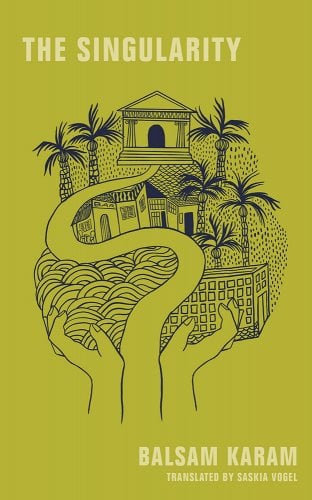[ad_1]
At the very beginning of Balsam Karam’s novel The Singularity (translated from the Swedish by Saskia Vogel), a pregnant woman stands witness as a woman lets herself fall off a cliff in her sightline, disappearing silently into the ocean. From there, time unspools forward and backwards, giving the reader insight into both past and future, but always returning to this same eerie moment in an unnamed country, on a road on a cliffside.
When you are a refugee, this novel suggests, time and space come together in a way that is impossible to counteract. It is impossible to move forward, yet impossible to go back, and most of all it is impossible to go home, both because of the literal distance and because that home does not exist anymore—it exists only in an imagined past that no longer feels real.
Time flexes and curls throughout the book, for both reader and characters. Karam skips, jumps, into the past, back to the present. But every moment of the present, the reader knows the woman will jump from the cliff. There’s no escaping that moment.
After all: when a mother is searching for her disappeared daughter, whose life may or may not exist given her undocumented status, what is time to that woman? On the beach, the mother wonders if her child will be there (in child form) when she turns around. She struggles to remember whether it was “a year or a lifetime ago” that she was in her stomach.
She also “no longer knows whether the homes on that distant hillside existed at all.” Up in an alley, her children wait, recreating old lives that now feel like a dream, unreal, like play. They recreate their old home out of sand. They don’t know what time it is. They don’t know how long it’s been since their sister disappeared, or how long it might be until she arrives. They wonder if this winter, they’ll get to live the life they were promised.
As the grandmother watches the children play from her spot in the alley, “she can see the movement of loss . . . she sees it all the time and fears it.” Loss is present, tangible, in both time and space.
The refugee’s life is reduced to waiting. The grandmother waits. The children wait; they have long stopped their gathering, their attempts to scrounge or keep things cold. The mother searches. The protagonist refuses to accept that her child was born dead. Instead, she waits. She believes on some deep level that if she does not leave the hospital, leave her bed, allow the doctors to remove the fetus, then her child has not really died, and cannot really die.
“Time and space will never meet above the city,” Karam writes, “and so the woman keeps moving, always away and always onward.” The loss inside her, she feels, has been there forever, and it will never end.
Months after the woman was witness to suicide, she has a miscarriage. But she refuses to allow the deceased fetus to be removed, despite all the doctors’ pleas. Hospitalized, she talks in monologue over and around the words of her doctors, her visitors.
“This isn’t temporary,” she says. “I don’t understand what I’m supposed to be moving past . . . I don’t understand what constitutes forward movement or even what forward is.”
When she and her family first fled their home for a new country, her grandmother wanted to stay with the earth of her home. She put her body against the earth, but it wasn’t enough. At Gran’s death, she asked to be sent home, but they couldn’t send her—she’s buried in the new country, in a cemetery.
When the woman—then still a girl—and her family fled, they left behind her best friend, Rozia. A young girl who was given the protagonist’s favorite dress. Who died in it. If Rozia’s house was bombed, her mother suggests at one point, theirs too must be in ruins. But “in my memory,” her mom says, “that house is indestructible, do you know that I mean?” They never saw the house, but they know that it occupies, in some way, the same space as Rozia’s house—and Rozia’s body shares, in a way, the same space as the woman’s body. She had planned to name her child Rozia, but Rozia is dead, and now, perhaps, so is the child—is that because they occupy the same space?
Inside a black hole, explains the pregnant woman at one point in the narrative, is a place called the singularity, where a force “pushes bodies together and renders the distance between them nil . . . eventually they occupy the same space . . . and if there’s no distance between two bodies, it’s pointless to go on talking about distance, right?”
Things blend, are indistinguishable. The most well-meaning people on the corniche cannot distinguish the Missing One’s face from that of any of the other missing refugees. The mother struggles to distinguish the past from the present. And she never will. The act of waiting “leeches” everything from the valley. The mother can’t recognize her own body anymore. The protagonist in the hospital tells the nurse that she has no home. Loss is inherited, loss is a constant. Once it’s occurred, it infiltrates the past as well as the present.
Ultimately, Karam’s book illustrates in vivid detail—in just 200 pages, intricate yet in accessible prose—the vivid trapped existence of refugees, of how they begin to live outside time and space, of how the world seems not to see or acknowledge their past or their presence, while denying them a future.

FICTION
The Singularity
By Balsam Karam
Translated from the Swedish by Saskia Vogel
Feminist Press
Published January 24, 2024

[ad_2]
Source link

